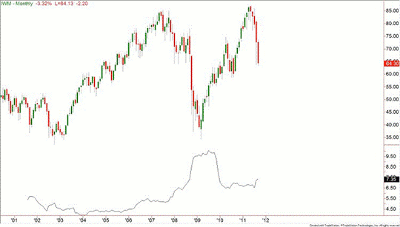These potential option spread trades on a popular ETF require a relatively small amount of seed capital, pay the trader a premium, and have nearly identical risk profiles.
In this MoneyShow.com article, we will examine a couple of option trading cases that only use $200 seed capital. Both option strategies will be done on the same underlying and with the same type of vertical credit spread. The only variation will be the width of the spreads.
Going through this type of comparison is a practical way to help the novice trader begin to see some of the many nuances that make up option trading.
Part One: A Single-Point-Wide Short Vertical
As an example, we are going to select a bullish vertical spread on iShares Russell 2000 Index Fund (IWM). Due to the fact that we are considering being a premium seller of monthly options, on Friday afternoon (9/30/2011) just before the closing bell, we should base our trading decisions off the monthly chart.
On the lower chart studies, we will pull up the Average True Range (ATR) indicator. In our case, at the time, the monthly ATR was 7.35, which means that in any given month, IWM is likely to move either up or down approximately that amount.
With IWM trading at $64.18, we can select a strike price 8 points lower, or at $56 to be exact. In that case, the distance between $64.18 and $56 is greater than 8 points (8.18 to be exact) which is well outside of the monthly ATR range of 7.35.
The premium pricing of the Oct 56 put (8.18 cents away from the current IWM price) was quoted at the bid for 0.85. We also had to buy the 55 put for protection at 0.71 (as the midpoint between the bid and ask), leaving us with a difference of 0.14, the total credit received. The sale of the 56 put is outside the range of the natural monthly "breathing" of IWM.
The 56/55 spread specifics are listed below:
Vertical 56/55 Credit Spread (Bull Put) on IWM 64.18
- Monthly Average True Range (ATR) = 7.35; our cushion is 64.18 - 56 = 8.18
- Cushion versus the monthly ATR: 8.18 > 7.35
This could be considered a conservative trade.
- Sell to open (STO) – 1 Oct [0.12 Delta] 56 put @ 0.85
- Buy to Open (BTO) + 1 Oct 55 put @ 0.71
- Max Profit (0.85-0.71) = 0.14
- Max Loss (56p - 55p) spread-width minus the credit
- Max Loss = 1.00 – 0.14 = 0.86
- Rate of Return (ROR) = 0.14/0.86 = 16%
In short, for this first example, we are risking close to $100 dollars per single contract and are able to make 16%, yet if we were to invest $200 and the trade worked out, then we would make twice as much on two contracts, or 0.32 to be exact.
Part Two: A Two-Point-Wide Short Vertical
Let us now turn our attention to the same bull put strategy except we will make the spread two points wide instead of one. The 56/54 spread specifics are listed below:
Vertical 56/54 Credit spread (Bull Put) on IWM 64.18
- Monthly ATR = 7.35 and our cushion is 64.18 - 56 = 8.18
- Cushion versus the monthly ATR: 8.18 > 7.35
This could be considered a conservative trade.
- STO – 1 Oct [0.12 delta] 56 put @ 0.85
- Max Profit (0.85 - 0.58) = 0.27
- Max Loss (56p - 54p) spread-width minus the credit
- Max Profit = (2.00 – 0.27) = 1.73
- ROR = 0.27/1.73 = 16%
What is interesting to observe is that the cost of doing this trade involves $200, and our profit does not go up at all. All things being equal, the sold 56 contract has the same possibility of being touched, so both trades, in terms of risk, are nearly identical.
In conclusion, the widening of a spread from a single-point strike increment to two points is really the functionality of the risk of the sold strike price rather than anything else. Knowing your options before you trade them is so essential.
By Josip Causic, instructor, Online Trading Academy






















